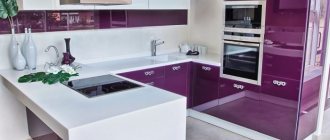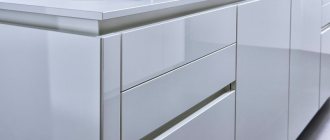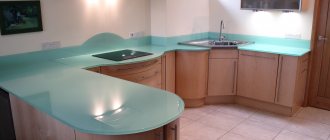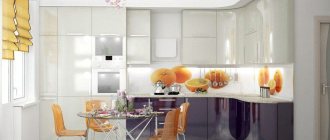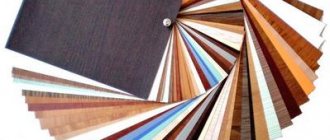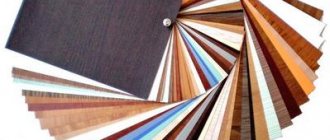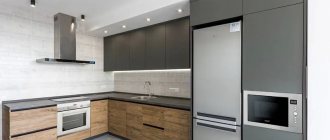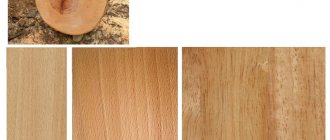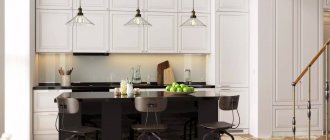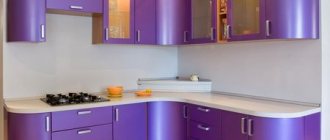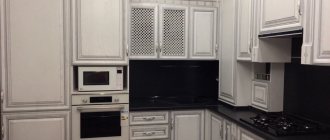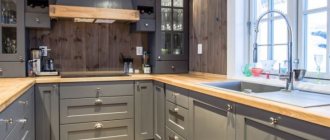Temperature changes, steam, grease splashes - this is just a small list of “problems” that kitchen furniture faces. It is obvious that not every material of painted facades (regardless of the type of dye used for painting) will withstand such harsh conditions of use. The massif quickly loses its shape and dries out. Metal surfaces require constant maintenance. MDF is considered optimal for purchase, characterized by a low price and high performance properties of the front panels of the headset.
Advantages of kitchen facades made of MDF
The main quality of furniture made from such material is its environmental friendliness. When heated, it does not release toxins or unpleasant odors that can harm human health. The specific composition of fiberboards protects the headset panels from rotting. Resistant to pathogens and fungi, they provide all the necessary conditions to maintain room hygiene.
Among the important operational properties of MDF facades are the following:
- increased strength;
- low degree of wear;
- environmental safety;
- resistance to temperature changes;
- resistance to moisture.
They can serve up to 20 years, maintaining their shape, quality and aesthetics. The price of furniture panels made of fibreboard is significantly lower than for analogues made of wood. Moreover, the latter indicator does not in any way affect the design restrictions. Taking MDF as a basis, you can implement a variety of solutions in kitchen interior design (glossy, matte effect, metallic, imitation wood, stone, etc., etc.).
conclusions
Other derivatives of the described varieties are determined independently; for example, an MDF tabletop can have individual dimensions that are not subject to any standard. Bent MDF boards are similar; their size is often determined by the size of the cell on which it will be attached.
Often the depth is 70-450 mm, depending on what MDF angles were used, chord sizes range from 250 to 1200 mm. The height does not exceed 2200 mm.
The dimensions of the boards and MDF trim are almost always unchanged in terms of length, only the width changes; usually options up to 700 mm are produced. MDF lining has standard dimensions of 2600x200x7 mm.
How does MDF differ from chipboard and solid wood?
Compared to particle board, MDF provides opportunities for the manufacture of facades of original shapes (convex/concave). The chipboard surface is a smooth film with a textured pattern. Furniture made from medium-density fiberboard is the base, which, along with PVC and paper-resin film, can be finished with plastic, veneer, and coated with paint. Yes, it is more expensive than front panels made of chipboard. But at the same time it is distinguished by higher quality and safety of use.
Unlike wood, facades with a fiberboard base are resistant to UV radiation. They do not require complex care. It is enough just to wipe the surfaces from time to time with a soft cloth soaked in a mild soap solution. Yes, they don't look so solid. However, with modern finishing and decorating technologies, you will not have any problems in realizing any design idea.
Areas of application depending on size
HDF boards are used in various fields.
- Furniture manufacturing. Most often they are used for drawers and back walls of high-quality furniture: cabinet or upholstered.
- They make excellent interior doors for offices, homes, cottages, cafes, and so on.
- Due to their high strength and reliability, the panels make excellent partitions. Their dimensions make it possible to build them at high speed.
- Interior work. The small thickness of the slabs allows you to save more usable space in the room. At the same time, it is possible to mount them not only on walls, but also on the ceiling, which significantly expands the list of areas of their application. They can be used as a backing for laminate flooring. The dimensions of the slabs help increase the speed of work.
- Kitchen aprons. Using various methods, patterns are applied to the slabs, and they make an excellent replacement for tiles. A reasonable price and no seams are a big plus in kitchen finishing. You can use non-standard sizes, while reducing material consumption.
- Decor. Grilles are made from these plates to hide ventilation holes and picture frames. They also make excellent screens that cover heating radiators from prying eyes; holes are cut into them for free passage of air.
- Finishing. Light weight and high reliability make it possible to use this material for upholstery of car interiors and passenger cars.
What should be the facades for a kitchen made of MDF - selection criteria
Fiberboards are manufactured in accordance with GOST 20400-80. In accordance with it, front panels with a headset made of such material are allowed:
- texture direction distortion up to 5mm;
- the presence of subtle risks under the film up to 8mm;
- “shagreen” with a protrusion on the front panel of the headset of no more than 0.05 mm;
- the presence of disguised chips, technological holes on the back side of the facade with a diameter of up to 6 mm (no more than 3 per 0.3 m2);
- microspots and small stripes on the surface of the film with a metallic effect.
The presented deviations are not an indicator of the low quality of the goods sold. The list of unacceptable defects includes film wrinkles, scratches, milling defects (chips, ribbing, waves on the edge). You should abandon the idea of buying a set made of MDF immediately if you find glue residues on its surface or peeling of the coating.
When choosing facades for the kitchen, you should take into account the emission class. Front panels marked E1 are optimal for living spaces. When heated, they do not emit a toxic substance - formaldehyde. Do you want your furniture to last a long time? Pay attention to its edges (they should be trimmed with aluminum or melamine plastic). Height-adjustable legs will not only allow you to install the set horizontally, but also prevent contact of its lower part with moisture when water leaks or when washing the floor.
Safety classification
We have already mentioned that there are no MDF boards that are completely safe for health; during their production, synthetic urea-formaldehyde resins are used in quantities of up to 120 kg/m3 and a hardener of up to 5 kg per cubic meter. All of them release formaldehyde into the air. Each country has its own requirements for the amount of harmful compounds; the permissible parameters are often influenced by the industrial lobby. We have three classes of formaldehyde emission: E0.5, E1, E2. The first ones are the safest, the third ones are prohibited for use in residential premises. But you need to know that physical strength is inversely proportional to the safety class. The more glue, the stronger the board, but the more formaldehyde is released.
Advantages and classification of MDF
Options for finishing kitchen facades made of MDF
The basis of the front panels of kitchen sets is fibreboard. As for their coating, it can be different: enamel, plastic, veneer, PVC film. Acting both as protection and as decoration of panels, all these materials have their advantages and disadvantages. We suggest studying each of them in more detail.
Facades finished with PVC film
Characterized by financial accessibility. The film of such sets can be painted in any tone of the RAL palette, different patterns and textures can be applied to it (see photo). Do you want her to not lose her beauty? Place the kitchen unit away from direct sunlight. To avoid the risk of damaging the coating, its surface should be wiped with a soft sponge using non-abrasive types of detergent.
Facades with decorative enamel coating
They are distinguished by a wealth of color and design solutions. Among their advantageous characteristics are heat resistance, resistance to moisture and odor absorption, and ease of maintenance. This type of furniture facades belongs to the most expensive category. Also among its disadvantages is vulnerability to mechanical damage (scratches, cracks, chips).
Plastic facades
Shows long service life. By choosing this type of front panels, you will appreciate their chemical resistance, hygiene, and ability to retain beneficial qualities even at a humidity of 80%. At the same time, be prepared for the fact that the inside of the facades will be white. The surface of the furniture will have to be wiped after each cooking (especially if it is glossy).
Veneer-clad facades
Provide maximum resemblance to natural wood. Their advantages include environmental friendliness, unchanged geometry, maintainability (small scratches and other damage are sanded, and the surface is restored using varnish). The disadvantage of this finishing material is the limited design. Not allowing for a paint option, it becomes duller over time. Under the influence of UV radiation, the colors of the decorative coating may change.
Design options for painted MDF facades
Different finishing methods make the design range of kitchens with a fibreboard base even wider. Just look at the decorative patina treatment of the front panels of the headset! The facade covering is artificially aged, and then framed with a golden or silver border along the relief elements. Through this effect, new furniture acquires the features of a noble antique. It perfectly complements the classics, as well as rooms decorated in Baroque or Provence style.
Painted facades are decorated with various decorative elements. These can be miniature frescoes, fancy ornaments, paintings. A current solution in kitchen design is photo printing. The use of such technologies allows you to make the front panels of the headset bright and original. And they, in turn, will fit perfectly into modern, high-tech and other trendy styles of room design.
Kitchen facades with 3D milling look unusual. Possessing a relief surface, they are covered with different patterns - from intertwined lines to flames and tree bark. With the help of such front panels, the headset can easily zone the room and visually eliminate its shortcomings. Moreover, they are easily combined with most materials and are suitable for integration into any stylistic solution of the kitchen and home.
Panel color
The work area can be decorated in the same color as the countertop. This method is successful if a popular design is being made - a single work area. A single color will visually separate the cooking area.
The color of the apron should not be provocative, because you will have to look at it often and for many years, but it should not be dull and dull.
You need to be very careful with gray color. It is beautiful and attracts attention, but not in the kitchen. A room decorated in this tone will be gloomy, but if you use them with this shade, but with splashes of yellow, gold, they will become a stabilizer.
Red and cherry shades are trending today. Popular green, natural wood, brown colors. According to designers, the colors of scarlet maple leaves, turquoise, and azure look beautiful in the interior. Shades in the Provence style, white gloss, and coffee with milk are in demand.
In the design of the dining room
When choosing the size of the apron for the kitchen, you need to take into account that it should extend a few centimeters beyond the top and bottom edges of the cabinets.
There is no such color that would be ideal for all kitchen sets and designs. His choice depends on personal preferences and the furniture used. Some choose to have its color match the main tone of the walls.
However, these colors can only match in two versions:
- If the wall where the furniture is installed is different in tone from the others.
- If you need to create a neutral environment.
Most designers agree that the color should be in harmony with the furniture, and it can be in the same color range or be contrasting. For a white model, a contrasting color is selected. After all, the white color itself is very boring, but with a bright combination it will sparkle in a new way. It would be good if the range of the apron was supported by accessories.
The color of the apron should not be provocative
It is more difficult to choose a panel if the furniture is of a certain color. Then the apron should match the color of the headset.
Fashionable combinations:
- light green and purple are unusual colors that look beautiful in tandem;
- yellow and green - a combination that suits different styles;
- white and red - can be used in small kitchens;
- white and dark gray - suitable for rooms of various sizes;
- rich pink and black – will add individuality and bright accents;
- bed shades and bright prints on the apron.
Such models can be thematic - with drawings and images. Images of fruits and vegetables are appropriate for the kitchen. But there may be other images on the panel.
The work area can be decorated in the same color as the tabletop
How to care for furniture facades made of MDF?
The service life of kitchen units depends on the strict adherence to the manufacturer’s recommendations:
- Use soft, lint-free cloths when cleaning the panels. They will not leave soap stains on the gloss, scratches after wiping, or removing dirt from the headset's coating.
- Avoid cleaning furniture surfaces with aggressive detergents. They can change the color of the coating and lead to deformation of the finishing material.
- Do not use polish when caring for facades. It attracts dust, making it difficult to clean furniture from dirt.
- Wipe the headset panels dry immediately after cleaning. If the coating is not sealed, moisture will penetrate inside and lead to swelling and changes in the geometry of the product.
For reference: the best way to deal with stubborn stains is to prevent their occurrence. In order not to spend a lot of time dealing with old stains, it is enough to wipe MDF facades after each use.
Dimensions
The wide variety of MDF panels has led to their widespread use in construction. Panels with appropriate dimensions are produced to suit the various needs of the construction industry. The dimensions and weight of the slabs are unified and regulated by technical production standards.
For wall cladding, wall panels are produced with dimensions of 2.62 meters in length. A number of manufacturers offer panels of 2.8 meters and 2.44 meters in length. The width corresponds to the type from P-1 to P-5.
| P-1 | 100 mm |
| P-2 | 125 mm |
| P-3 | 150 mm |
| P-4 | 175 mm |
| P-5 | 250 mm |
MDF boards are available in lengths and widths of 1.5 meters x 0.1-0.9 meters. The size of the slab depends on the texture of the surface - embossed, perforated and panels with imitation of natural stone reach sizes of 2.8 by 2.07 meters. Square panels for decorative panels have other sizes - from 29x29 cm to 95x95 cm. The thickness of laminated and painted panels varies from 3 mm to 30 mm.
The weight of the panel depends on the size, presence of veneer or relief. To get an idea of the average weight of this finishing material, you should focus on a weight of 16 kg for a panel with dimensions of 2.8 x 2.05 x 0.003 meters and a weight of 142 kg for dimensions of 2.8 x 2.05 x 0.028 meters. For the ceiling, thinner and lighter products are used; for walls, panels with a high coefficient of strength and resistance to mechanical stress are used. If you need to create sound insulation using MDF finishing, you need to select the maximum thickness of the slab. Of course, the weight of such a structure, if the height of the room is large, will be significant.
Veneer and relief increase this indicator. Perforation, on the contrary, reduces the weight of the structure. For small surfaces, select panels or slabs of smaller sizes, since cuts will disrupt the decorative finish and create difficulties in sealing seams. It is better to decorate large premises with large-sized slabs and panels.
